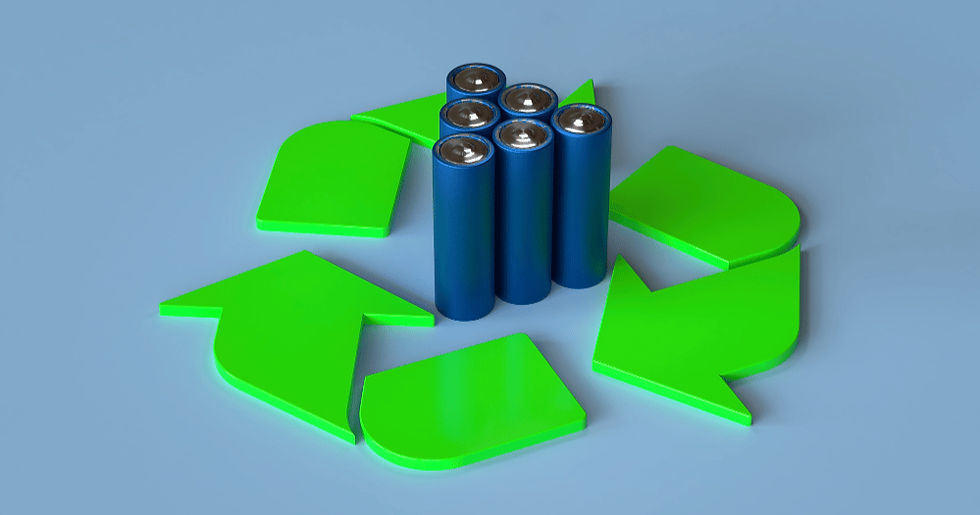What happens to the battery in your old smartphone once you get rid of it? Once an afterthought, now extracting valuable metals from discarded phones, electric vehicle batteries, and countless other gadgets that power our digital lives is a thriving industry.

And as the global appetite for portable electronics and electric vehicles continues to surge, so does the mountain of spent lithium-ion batteries. But can we keep going like this?
Why Lithium-ion Batteries?
In the world of electronics and electric vehicles (EVs), various battery types have been tested. But Li-ion batteries emerged as the superior option. [1] [2]

Lead-acid and lithium batteries remain at the forefront, each with specific pros and cons, particularly concerning recycling. Lead-acid batteries, which have been used since the 19th century, are favoured for their reliability, power output, and cost efficiency. But they are heavier and don’t last as long as lithium batteries.
Recycling Key To Sustainability for Batteries
Since 2010, the demand for lithium-ion batteries has skyrocketed powered by electric vehicles (EVs) and renewable energy storage. Effective management of these batteries is vital because of their valuable materials, such as lithium, cobalt, nickel, and graphite.

Recycling them helps reduce environmental harm, conserve resources, and reduce the need for fresh raw materials. By reclaiming essential materials, recycling promotes a more sustainable supply chain, lowering the ecological impact of both battery production and disposal.
Materials used in EV battery casings, particularly metals like cobalt, nickel, manganese, and lithium, are expensive and limited. These metals, essential for battery cathodes, can cost between $4 and $35 per kilogram. If metal recovery isn’t improved, we could face a supply shortage by the 2030s. [8]
In fact, the market for battery recycling is moving surprisingly fast, especially considering that these batteries can last over a dozen years — and potentially much longer.
Many batteries even outlast the vehicles they power and can be repurposed for secondary uses.
However, first-generation EVs are now starting to reach the end of their lifespans, increasing the need for battery recycling.
Recycling Beats Mining
Currently, battery recycling primarily focuses on recovering raw materials from gigafactory scrap, but that’s just the beginning.

PwC estimates that by 2040, up to 60% of the materials used for battery production in Europe could come from recycling old batteries, thanks to advancements in recovery processes. Recent breakthroughs in recycling technology, combined with other innovations, suggest that within the next decade, the global demand for raw materials to build new batteries could largely be met by recycling existing ones. [4]
Zeng Yuqun, the founder and chairman of CATL, a major power cell company, predicts that by 2042, half of all lithium-ion batteries could be manufactured using recycled lithium. [7]
According to the latest report by Straits Research, the global lithium-ion battery recycling market was valued at USD 13.93 billion in 2023. The market projection is for significant growth, reaching USD 53.40 billion by 2032, with a compound annual growth rate (CAGR) of 16.1% during the forecast period (2024-2032). [5]
According to RMI, an American think tank, the mining of raw materials for battery production might peak by the mid-2020s. RMI forecasts that by 2050, we may be able to entirely avoid mineral extraction for batteries.
This is driven by advances in recycling technologies and battery chemistry, which enhance energy density and reduce reliance on raw materials.

Innovations Will Decide The Future
We are seeing a lot of progress on the innovation side, with new techniques emerging constantly.
There is graphite recycling, where adding fluorine could slow down chemical reactions, reducing battery degradation and enhancing performance.
The second area is the recovery of electrolytes, a complex task due to their chemical instability and difficult extraction process, though researchers are seeking more efficient solutions.
Lithium extraction is being revolutionized by new methods to recover LiPF6 and lithium salts from black mass. [8]
The Battery Recycling and Water Splitting (BRAWS) technology developed by scientists at Ames National Laboratory offers several key advantages over traditional lithium-ion battery recycling methods in terms of efficiency. It uses only water and carbon dioxide, eliminating the need for harsh chemicals or high heat used in traditional methods. This results in a more environmentally friendly process with no toxic byproducts. [9]
Other innovations appeared only in the last year:
Researchers at Chalmers University of Technology developed a method using oxalic acid to recover lithium and aluminum first, which recovers 100% of aluminum and 98% of lithium and uses environmentally friendly oxalic acid instead of inorganic acids.
A team from Rice University pioneered a technique called solvent-free flash Joule heating (FJH), which quickly heats battery waste to 2,500 Kelvin in mere seconds. This process forms magnetic shells around the materials, simplifying their separation and achieving a 98% recovery rate for battery metals. [10]
Efficiently recycling Lithium-ion batteries is extremely important. What once seemed like a daunting task is now turning into a multi-billion-dollar industry, with new progress being achieved every day.
It is paramount to keep innovating and finding ways of recycling and repurposing old batteries.
References
https://e-vehicleinfo.com/why-lithium-ion-batteries-used-in-electric-vehicles/
https://blog.discoverbattery.com/a-deep-dive-into-lead-vs.-lithium-battery-recycling
https://www.npr.org/2024/06/27/nx-s1-5019454/ev-battery-recycling-us
https://www.weforum.org/agenda/2024/06/jumpstarting-lithium-battery-recycling-investing-innovation/
https://www.sciencedaily.com/releases/2024/07/240724171602.htm
Comentarios